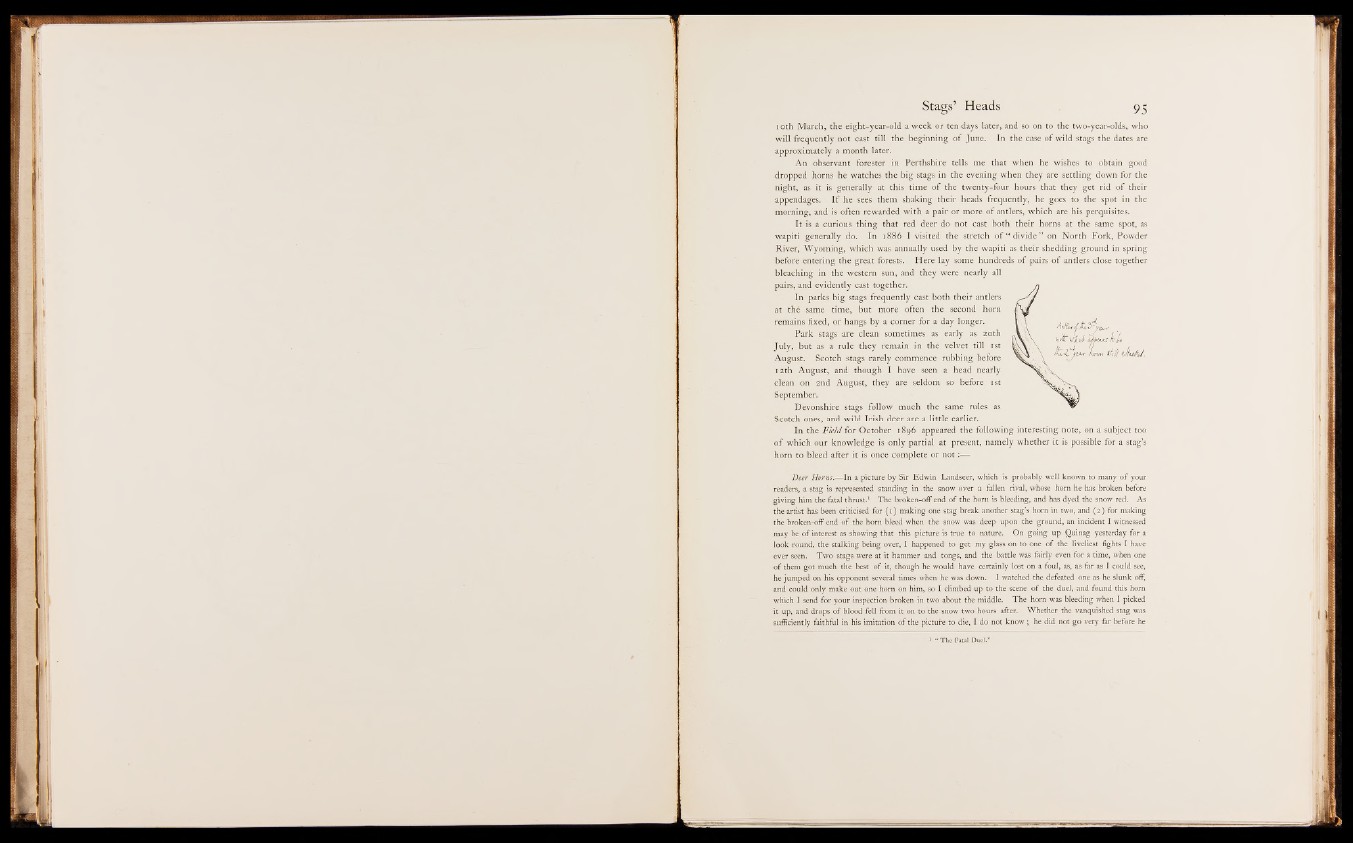
10th March, the eight-year-old a w eek or ten days later, and so on to the two-year-olds, who
will frequently not cast till the beginning o f June. In the case o f wild stags the dates are
approximately a month later.
An observant forester in Perthshire tells me that when he wishes to obtain good
dropped horns he watches the big stags in the evening when they are settling down for the
night, as it is generally at this time o f the twenty-four hours that they get rid o f their
appendages. I f he sees them shaking their heads frequently, he goes to the spot in the
morning, and is often rewarded with a pair or more o f antlers, which are his perquisites.
It is a curious thing that red deer do not cast both their horns at the same spot, as
wapiti generally do. In 1886 I visited the stretch o f “ divide” on North Fork, Powder
River, Wyoming, which was. annually used by the wapiti as their shedding ground in spring
before entering the great forests. Here lay some hundreds o f pairs o f antlers close together
bleaching in . the western sun, and they were nearly all
pairs, and evidently cast together.
In parks big stags frequently cast both their antlers
at thé same time, but more often the second horn
remains fixed, of hangs by a corner for a day longer.
Park stags are clean sometimes as early as 20th
July, but as a rule they remain in thé velvet till 1st
August. Scotch stags rarely commence rubbing before
12 th August, and though I have seen a head nearly
clean on 2nd August, they are seldom so before 1st
September^
Devonshire stags follow much the same rules as
Scotch ones, and wild Irish deer are a little earlier.
In the F ield for October 1896 appeared the following interesting note, on a subject too
o f which our knowledge is only partial at present, namely whether it is possible for a stag’s
horn to bleed after it is once complete or not
Deer Horns.—-In a picture by Sir Edwin Landseer, which is probably well known to many of your
readers, a stag is represented standing in the snow over a fallen rival, whose horn he has broken before
giving him the fatal thrust.1 The broken-off end of the horn is bleeding, and has dyed the snow red. As
the artist has been criticised for (1) making one stag break another stag’s horn in two, and (2) for making
the broken-off end of the horn bleed when the snow was deep upon the ground, an incident I witnessed
may be of interest as showing that this picture is true to nature. On going up Quinag yesterday for a
look round, the stalking being over, I happened to get my glass on to one of the liveliest fights I have
ever seen. Two stags were at it hammer and tongs, and the battle was fairly even for a time, when one
of them got much the best of it, though he would have certainly lost on a foul, as, as far as I could see,
he jumped on his opponent several times when he was down. I watched the defeated one as he slunk off,
and could only make out one horn on him, so I climbed up to the scene of the duel, and found this horn
which I send for your inspection broken in two about the middle. The horn was bleeding when I picked
it up, and drops of blood fell from it on to the snow two hours after. Whether the vanquished stag was
sufficiently faithful in his imitation of the picture to die, I do not know ; he did not go very far before he
1 “ The Fatal Duel.”